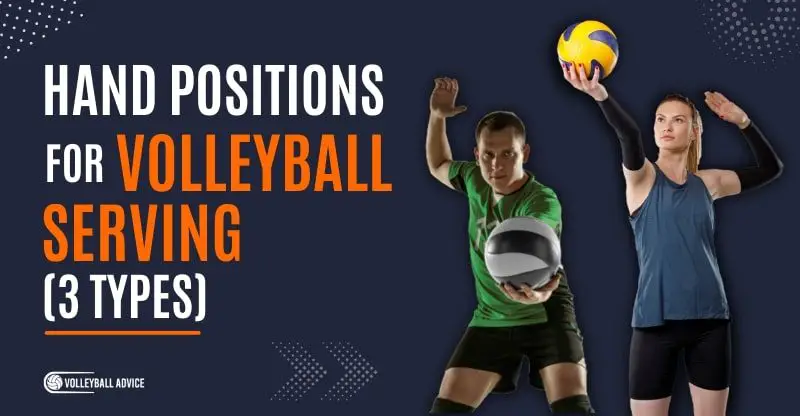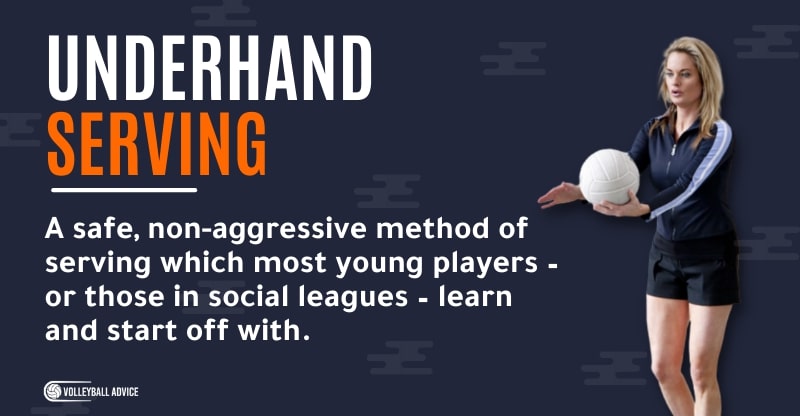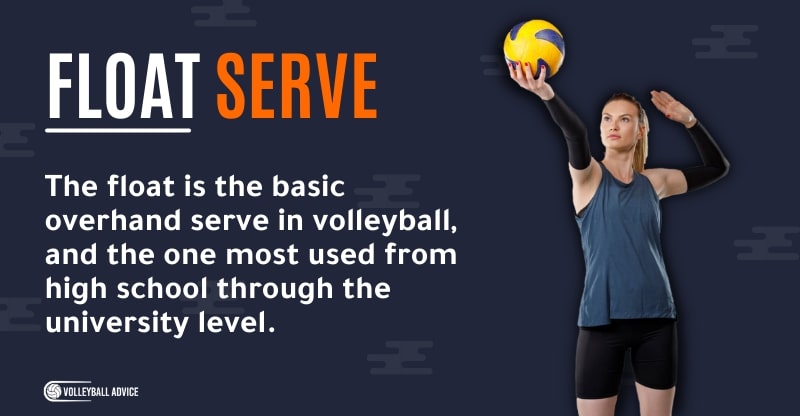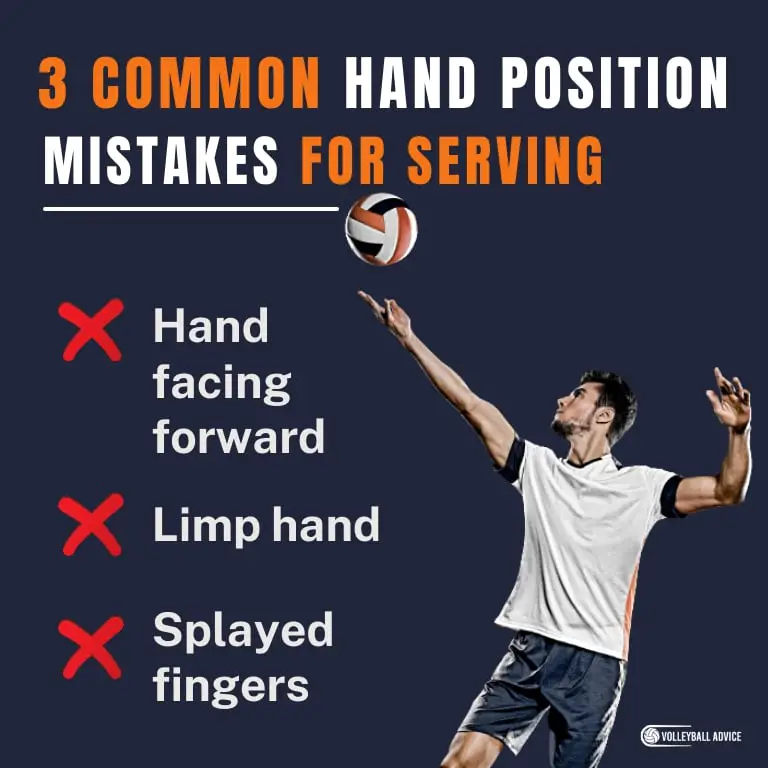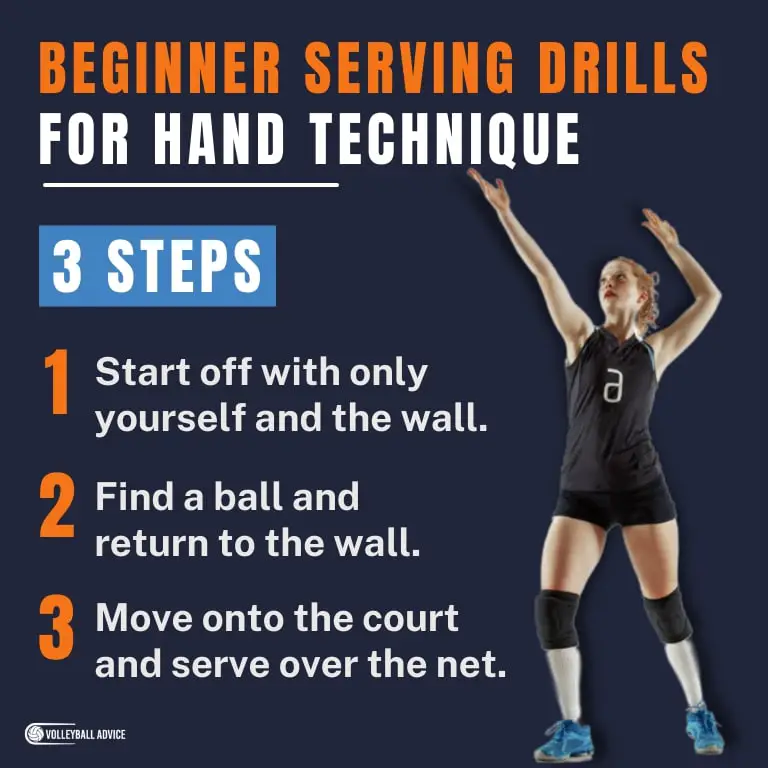Hand Positions For Volleyball Serving (3 Types)
Hand positions for serving make a huge difference. Small changes can alter the trajectory of the ball massively, making the difference between your serve landing within bounds or out.
Despite this, hand positions for serving in volleyball are often overlooked in favor of mastering footwork, the toss, or arm swings.
While these are all equally important, hand positions should not be overlooked as they train the moment you contact the ball and how you control the angle.
Being mindful of every part of your body while playing will change you from being a good player into a great one.
So, what are the hand positions for serving in volleyball? There are three hand positions for serving in volleyball: underhand, float, and topspin. For underhand, form a fist and contact the ball with the bottom of your fingers and ball of the thumb. For float and topspin, begin with palm outwards near your head and contact with your palm, following the correct arm movements.
A good serve requires a good toss and good form to succeed, and this includes using proper hand positions. Doing so will not only improve your game, but will mark you as a player worth watching in the eyes of scouts, coaches, and other experienced players.
In this article, I will be discussing:
- The three hand positions for serving
- A list of common mistakes and how to fix
- My number 1 drill to practice serving
What Is The Proper Hand Position For Serving?
Proper hand position for serving is broken into three parts: underhand, float, and topspin.
The second two are both overhand and are the primary methods of serving from high school onward, but underhand is still worth detailing for middle school players, social leagues, and some advanced beach volleyball techniques – which I will cover in a different section.
1. Underhand Serving
Underhand serving is a safe, non-aggressive method of serving which most young players – or those in social leagues – learn and start off with. This is because the swinging motion from low-to-high gives the ball the easiest chance of making it over the net, sacrificing power for safety.
For casual play or anyone just starting out, underhanded serves work perfectly well and can even achieve surprising amounts of accuracy. Like the arm motions involved, the hand position is equally as simple.
Hand Position
- To set up the correct hand position for underhand serving, simply form a fist with your hand and strike the ball with the bottom of the hand (palm up), contacting the ball with the flat of your fingers, ball of the thumb, and edge of the palm.
- This makes a wide, flat surface that will direct the ball exactly where you need it to go.
2. Float Serve
The float is the basic overhand serve in volleyball, and the one most used from high school through the university level. Its strengths come from its unpredictable movements mid-air, which in turn come from a silent (non-spinning) toss and a flat contact with the ball.
Because of this, hand position is incredibly important to perform a great float serve – though not particularly hard.
Hand Position
- Float serving is an overhand serve, so begin with your arm pulled up into the “shooter’s pose” – your shoulder to elbow should be level with the ground – and hand near your head, palm facing outwards.
- Your thumb should be downwards, which will force your elbow into an extra rotation before hitting, adding power to the serve.
- Your fingers should be together and extended stiffly to create a hard, flat surface on which to contact the ball.
- Keep this tension throughout the float serve, and aim to contact the ball in the center of your palm. This will give it the best chance of floating.
- After contact, your hand should maintain its stiffness, not relaxing or rolling into a finish like with topspin serves. This will cause the ball to spin, in turn eliminating the floating quality from it altogether, essentially ruining it.
- The essence of a float is its “silence”: the toss doesn’t spin, the ball doesn’t spin, and your hand should never relax from its single stance either, lest it ruin the first two and ruin the serve.
3. Topspin Serve
Topspin serves are aggressive, fast serves that intimidate players with their noise and ferocity. Alone out of the different types of serving, their hand positions change as the serve occurs, making this the most difficult to perform.
While they are the hardest serve to master, topspin serves are simple to describe. Their swing and hand positions are identical to spiking – only aimed a little higher.
Hand Position
- To begin, start in the “shooter’s pose”, with hand stiffened and identical to the beginning of the float serve with the palm near your head, facing outward.
- As you contact the ball, roll your hand over the top of the ball, creating spin, and finish with your wrist snapped downward as your arm follows through.
- This shift in hand position is what gives it the spin and makes it powerful, but doing it incorrectly can lead to shooting the ball out of bounds instead.
Related Article: Footwork For Serving A Volleyball: Technique, Drills, Errors
3 Common Hand Position Mistakes For Serving & How To Correct
1. Hand Facing Forward
Having your hand facing forward is a common mistake in hand positioning for volleyball, and one which many beginners make frequently.
It might seem like common sense to point your hand towards where the ball is going, but this eliminates the arm torque and rotation which gives your serve its power. This may be one reason your new players are serving into the net.
Keep your arm raised with your palm facing outward – to the side – from your face, and rotate your arm through the ball as you serve. Your palm will naturally align forwards with your target, and your serve will be all the stronger for it.
2. Limp Hand
A limp hand is the sign of a depressed (or anxious) server – or a lazy one.
This is often brought on by the perception that they cannot get the ball over the net, or a preoccupation with someone watching them, or failing in front of their peers. Being in their head causes them to lose track of their actual serving form, whiffing the serve after all.
A limp hand takes away power from the serve and fails to direct it where you want it to go. It’s important to keep your hand stiff and able to contact the ball properly, or it will simply go in the net.
If this is brought on by laziness, give that player a break to sit out and rest for 5 minutes. Boredom on court beats boredom on the bench, and they will quickly become interested in playing again. Wait until they begin serving again and correct their form if it’s still wrong.
For the depressed (or anxious) server, reassure them and correct their form immediately before they can get any more in their head. Stay with them until they make a good serve, and ask them what they did correctly.
Having them focus on the positives instead of negatives will bring a lasting change in confidence that will eliminate limp hands entirely, and solve a few other problems at the same time.
3. Splayed Fingers
This mistake is extremely common in serving, and everyone has done it at some point. Splaying your fingers (or spreading them) detracts from your hand’s strength when serving and causes the ball to drop short or move unpredictably, making it hard to aim.
Additionally, contacting with the fingers themselves create a “springing” motion that is entirely useless to servers everywhere.
To fix this, simply rejoin your fingers and extend them stiffly. This will make the perfect surface off of which to serve, and provide enough power to serve proficiently.
Beginner Serving Drills For Hand Technique (3 Steps)
When it comes to serving in volleyball, there’s no practice as beneficial as just doing it.
However – especially for new players – this can be entirely unhelpful when they don’t know where to begin. That’s why I recommend a developmental serving drill – one which expands as your expertise grows.
Step 1: Start Off With Only Yourself And The Wall
Stand close enough that you can reach up and touch the wall where you would normally contact the ball (slightly above and in front of you, a little farther than the tip of your toes). Prepare your serving motion and move through it, focusing on your hand position.
Ask yourself: Is it consistent throughout?
Contact the wall (gently!) at the proper height and pause, considering the shape of your hand and how it conforms to the wall.
As yourself: Is it uncomfortable? Are there any joints sticking out?
These are both signs that there may be something wrong with your hand position – one which could lead to an incorrect serve.
Start over and try again until satisfied.
Note: You can even stretch your serving muscles before a match by pushing into the wall when in this pose.
Finish by following through (for topspin serves) or by returning to start.
The purpose of this step is to force players to be aware of how and where they contact the ball, and how to improve their hand position to make it better. While not a lengthy segment, it is important.
Step 2: Find A Ball And Return To The Wall
You will be performing the same motions with the same awareness of hand positions as you did last step, only this time you will be contacting the ball. Step forward and serve the ball into the wall, catching it as it returns.
What do you notice?
The purpose of this segment is for players to understand ball handling and how it reacts to their hand position.
This is the time to make last minute adjustments before moving on to the net. Again, not a lengthy step, but an important one.
Step 3: Move Onto The Court And Serve Over The Net
Now it’s time to serve over the net, focusing not on footwork, but on hand position.
How does it affect your arms?
How do minute changes affect the trajectory of the ball?
Add in mindfulness of other elements, and continue serving until satisfied.
Advanced Hand Position For Serving
Hybrid Serve
A hybrid serve is – as the name implied – a hybrid between a float serve and a topspin serve. While you can read more about it in my article “Types of Serving in Volleyball”, the hand positioning is unique and should be further addressed here.
The hand positions for float and topspin aren’t too different, only changing as the serve proceeds, and Polish National Team player Mateusz Bieniek uses this to his advantage by mixing up his toss – not the hand position.
But the hybrid serve has another hand position unique to itself and pioneered by Japan national team player Yurie Nabaya, one which uses hand positioning to its greatest advantage.
This is the “cobra style”.
This style completely changes the way the body stacks itself when serving, changing the arm’s swing, but allows the player performing it to either float serve or topspin, changing it up at the last minute.
The hand position involves facing the palm forward and curling the elbow, wrist, and hand into a cobra shape, allowing it to either whip or extend forward depending on the player wishing to do a float or a topspin serve. Deadly in the right hands, this is a very advanced serve that takes a lot of practice to perfect.
The dangers to this serve are numerous: not understanding body mechanics can lead to injury, and trying this in a match without practice will result in failure. If you’re further interested in learning about this serve, check out this video of Yurie Nabaya using it in action.
Skyball
A sky ball is a kind of serve used exclusively on the beach, and involves hitting it as hard as you can directly upwards to fall on the opponents side of court like a meteor. With a ridiculously low rate of success even at pro levels, this serve is more for fun than anything, but when done correctly is nearly unreturnable.
The hand positions for the skyball differ greatly, with some players preferring to use the outside of their hand for extra spin.
Personally, I use the same technique as when underhand serving, but stand sideways instead of forwards. This allows the angle of my body to naturally direct the ball over the net, despite aiming straight up.
To learn more about this, check out our friends at Better At Beach Volleyball below!
Frequently Asked Questions:
What Part Of The Hand To Hit A Volleyball Serve?
Always hit a volleyball serve with the palm of the hand. This will give it both power and accuracy when moving. Even when underhand serving, with a fist rather than open hand, we contact the ball with the palm facing upwards, forming a nice wide platform to serve with.
Do You Serve A Volleyball With An Open Or Closed Fist?
For overhand serving, you will serve with an open hand. For underhand serving, you will serve with a closed fist.
Do You Serve A Volleyball With The Wrist Or Hand?
Always serve a volleyball from the palm of the hand, as this will give power and accuracy. Serving with the wrist takes away both of these things, eliminating the movement of the wrist and hand that gives your serve control.
Hand Position For Other Volleyball Skills
- Hand Position For Volleyball Bumps, Passes, and Digs (6 Rules)
- Hand Position For Setting In Volleyball (7 Steps)
- Hand Position for Spiking in Volleyball (Tips and Tricks)
About The Author
Ailan Samuel is a writer and athlete who has played volleyball at the university, club, and national level since 2012. He has competed successfully in both beach and indoor competitions, resulting in four silver and two gold medals, and was awarded the Half-Blue while playing in Scotland. He received his MA in English and Medieval History from the University of St Andrews, Scotland, and is currently studying for his MA in Publishing and Creative Writing at Bournemouth University.

